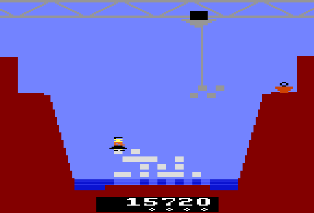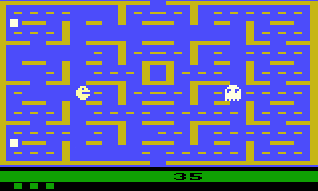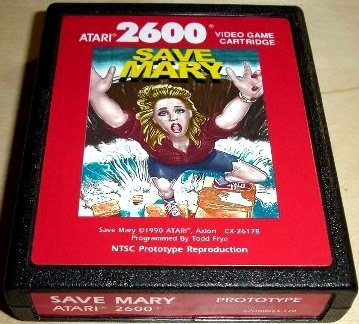SAVE MARY!
Tod Frye makes up for Pac-Man and the Swordquest games
by Chris Federico
Excerpted from the Classic-Gaming Bookcast

In the occasional documentary or imitation documentary, some guy's curiously testosterone-free voice will declare that the late-1982 game E.T.: The Extra-Terrestrial is the worst ever made. The odd writer with scant grammatical skills will claim that it's merely the worst game ever made for the Atari 2600.
Complete nonsense, all of it, of course. While E.T. might have been one of the worst movies ever made, the game is quite compelling, provided that the player is fond of exploration adventures (with random elements, at that), plays Game 3 to forego the irritating bad guys, and isn't afraid of manuals. If he's not into that sort of thing -- you know, thinking -- fair enough, but simply not caring for something is a far cry from justifiably pronouncing it poor. Incidentally, anyone who truthfully has a hard time avoiding the wells isn't very good at video games.
A couple of friends and I had a blast playing Howard Scott Warshaw's two-month project when one of them brought it over in early '83. I purchased it, as well as the same programmer's captivating Raiders of the Lost Ark, as soon as I could afford to – i.e. when several cartridge prices considerably dropped a few months later. None of us kids perceived a "crash," even if the industry itself was painfully lurched when the gravy train stopped.
There was no doom and gloom in our eyes. The industry's short-lived submergence worked in our favors, not against them. As far as I was concerned, it was a wonderful time, as the easily understood retailer habit of overstocking had begotten two-dollar games at the nearby Revco drug store.
The whole affair is a bit overstated these days, especially regarding its impact on players. In magazines like Electronic Games, the tribulation was reported as an inevitable shake-out of the companies that had jumped onto the gold-mine cart and released shoddy rip-offs. Once the inexpensive console games grew sparse, many of us simply added eight-bit computer libraries to our collections. Be assured that we didn't stop playing for a second, kiddos.
If you'd really like to know what Atari's reputation never recovered from, it was Tod Frye's conversion of Pac-Man, to begin with. It's not a bad game, but it's not Pac-Man. As it was released in the spring of '82, the shake-out wouldn't transpire for quite a while; but most players rightly or wrongly expected something closer to the arcade original, especially given the venerable VCS translations of Space Invaders, Asteroids and Missile Command. (I don't think that the brilliant Berzerk conversion came out before Frye's infamous endeavor.)

The swine in suits had chosen inexcusable cheapness and limited Frye to 4 KB. They'd been correct in expecting massive sales based on the title alone, but the company would never fully recapture its devotees' face-value esteem. Irrespective of the programmable-console industry's relative youth, '80s players weren't obtuse. When we saw the game, we realized that even Atari wasn't above cheating us after all. At that time, it was tantamount to learning that Walt Disney had been a deer hunter.
While we're on the subject, Coleco did the same thing to Garry Kitchen when he tackled VCS Donkey Kong. He nailed the mechanics and basic feel of the game admirably, never mind that the villain looks like a Christmas cookie and the fireballs have been turned into telephones. Also, horizontal asymmetry, which makes the ramps possible, is incredibly difficult to achieve on the system; but he did it.
He's since remarked that had his request for another month and another 4 KB been granted, he could have cleaned up some graphical details that bothered him, and added the missing arcade screens. Two repugnant things have been the banes of video games at large since the '70s: deadlines and executives.
Poor Frye subsequently wrote the latter two installments in a series that cemented the shoes of Atari's standing once and for all, even if the non-centering analogue controllers of the "new" Atari 5200 "console," as well as its already antiquated arcade-port release titles, certainly didn't help. There isn't a worthwhile Swordquest game among the three that were ultimately issued, but FireWorld is the worst. It plays like a graphics crash. (Maybe if you "Frye" the console by quickly turning the power off and on, the game's a lot of fun.)
Like EarthWorld and WaterWorld, the second game isn't so much an adventure as an assortment of buggy, arcade-derivative sub-games, tied together with corridor transitions in which nothing actually happens. It's like a really bad Gorf. The Swordquest series, together with certain third-party games, were what truly convinced players to stop buying fully priced 2600 software.
I've brought all of this up to disclose that Frye finally redeemed himself. He wrote a fantastic action / skill program that integrated some puzzle elements. And wouldn't you know it! The damn game never came out!
I suppose that we can count its inclusion on the Atari Flashback 2 pseudo-console that appeared a couple of decades later. I don't have one of those things; I do, however, have the emulated ROM, and it turns out that Save Mary! is one of the most enjoyable Atari 2600 games that I never played in the '80s.
If you look for the binary image of this unreleased Axlon/Atari gem, you'll want to avoid the version whose title screen is bordered in purple and displays a 1989 copyright. It doesn't include all of the power-ups. The one that I've been playing for a few years has a title screen that features Mary herself and a 1990 copyright. This revision actually seems to have been completed; new elements make their entrances quite far into the game. The level-by-level pacing of the difficulty and power-up additions has been noticeably carried out. It's a shame that it was never manufactured. Even Atari founder and Axlon chief Nolan Bushnell enthused about it in interviews.
Frye is rumored to have worked on the game intermittently for two years. He was concurrently coding another unissued Axlon program, Shooting Arcade. In 1997, eight prototype Save Mary! cartridges were found in the Atari warehouse that Best Electronics had acquired. Based on descriptions from the period, I get the idea that some or all of them contained the incomplete '89 game. The later version, which we'll be discussing, might have surfaced later on, but this is pure conjecture.
While it incorporates a vaguely Tetris-like element, it's another game that's unique in its combination of ingredients, and the overall concept is extremely inventive. In fact, it's outright constructive, as explained below.

As with us men, there are intelligent women and not-so-intelligent women. Mary has decided to take a stroll along the bottom of a deep pit that's slowly filling with water. Maybe a piece of her jewelry fell into a sewage-treatment plant. You know how they can be when it comes to shiny things. It's up to the player to drop bricks into the pit, one by one, that will ultimately allow Mary to climb high enough to be rescued. Your unseen character might simply have been the unlucky construction worker who was hanging out in the crane, peacefully eating his lunch, when he heard the cries for help.
Slide the crane (or the tram, or the giant fishing reel, or whatever it is) back and forth along the top, finally grabbing a brick from the upper left or right cliff by pushing and holding the fire button. Each brick scrolls slowly onto the screen and dissolves in the apparently noxious air above the treatment plant if you don't seize it within a few seconds.
Your ability to decide between the emerging left and right bricks is vital during most of the game; the first level is the only one that contains a single shape, which is a rudimentary rectangle that can always be stacked on top of itself, so to speak.
Drop each brick into the water or onto the pile by finally releasing the button. Take care not to squash Mary, since it never occurs to her to get out of the way. In other words, your biggest challenge while attempting to save Mary is that Mary is a moron. Perhaps the fact that her eyes are on opposite sides of her head makes it difficult for her to see. You periodically have some control over her, however, thanks to certain power-ups; but I guess Mary Command wouldn't have been such an appealing title to some.
You can lower the crane's cable (or the fishing line) until it's roughly level with the lower cliffs, and raise it nearly all the way up. Its invisible lower boundary explains why Mary has to reach an elevation from which you can grab her. The level is completed when you've deposited her onto one of the lower cliffs.
She'll ascend every time you add a brick that makes your impromptu structure one level higher, so at least she knows enough to get away from the water, which is steadily rising. She can't scale two platforms at once, so another part of the challenge is in ensuring that the bricks are stacked gradually, in something of a staircase fashion. She'll hop over reasonably narrow gaps while she scurries to and fro for no logical reason.
Aligning the bricks isn't pixel-picky; when you drop one, it will shift a bit to the left or right, lining up with the invisible grid to which your growing stack conforms. This can be handy or aggravating, depending on whether or not the brick relocates itself to the X position you're aiming for. The implied framework is composed of minute intervals, so things aren't as crude as they would have been in, say, a 1977 game; the automatic nudging is only just perceptible. There's a lot of leeway, in terms of assembling your own edifice.
Moving diagonally to slide the crane to the side while lowering the chain at the same time, and then gracefully circling back up and over to grab another brick – it's all very smooth and satisfying, like a video milkshake. The elegant game-play is partly contingent on the watertight control responsiveness.
There's also a powerful feeling of accomplishment in completing a level. So many games rely on destruction (which is obviously pleasurable in itself) that it's riveting to construct something for once. The funny thing is that this broad just keeps jumping right back into the water when she's been rescued. It's fair to argue that she's increasingly at fault for her predicament. She clearly can't be trusted around pits with leaks in them. I think that the real way to save Mary is to buy her a ticket to another city.
For now, you'll have to hoist her out of there before the water level surpasses her head. The risk-versus-reward aspect comes into play, especially when the water's rising faster on later levels. If you're the high-scoring type, you'll want to keep in mind that when you rescue her, you receive bonus points according to the amount of piled bricks. It's an odd way to reward the player: "You had higher priorities than getting her out as quickly as possible! Great job!"
This bonus is of course only a supplement to the in-game points earned for each brick that lands intact. If you release one too far to the left or right, or drop it onto another without giving it enough surface to land on, it will fall into the water and disintegrate. No wonder Mary won't swim; that stuff is highly polluted!
Whenever you've taken hold of a brick that you realize you don't want, it can be released to one extreme side, and you can get back to waiting for the shape that you're after. Until you grow accustomed to eyeballing Mary's altitude, you'll be able to tell that she's high enough for rescuing when bricks won't fit anywhere on top. If you swing one into her, it produces the same effect as carelessly dropping it. In other words, you might as well finish your lunch and hope nobody's noticed that you've just killed a semi-innocent woman.
The power-ups appear randomly on the lower cliffs. You can stop the water from rising momentarily if you grab the giant drain plug before it disappears. It will sit there for a few seconds or just an instant, like any bonus object. If a new brick is just emerging onto the upper cliff, the power-up will vanish, since it can't coexist with a brick on the same side of the screen (unless you're carrying one or the other). This unfortunate timing is all I can think of that might have been rectified if Frye had continued fine-tuning the game.
Activate a power-up by dropping it onto either upper cliff. The drain plug is a spot-on inclusion; it really helps after the first few levels, when the water's rising faster and you have to work quickly. The red octagon is a stop sign that temporarily keeps Mary from running all over the place. Thankfully, she'll continue to climb higher when given the opportunity.
The numerals that sometimes appear in lieu of the helpful things are mere score bonuses. 1 means 100 points, 5 means 500, etc. These must be placed on the upper cliffs like the proper power-ups.
When you've completed four levels and started over with the first type of brick (on what can be considered the second macro-level), new objects are introduced, including the physics-defying golden brick. This briefly allows you to drop the normal bricks through Mary without hurting her. Its gleam evidently captures her attention, and she finally thinks to wander in front of the falling heavy things, just to get a better look. It's not long before she starts to panic again and assumes a vulnerable position.
A megaphone would have been a useful power-up. "Quit moving around down there, will you? Do you want to get out or not? In order for me to help you, Mary, you'll have to help yourself. Just feel lucky that I've taken the bait off this hook!" If this is indeed a fishing line, it sure is strong. Call the construction companies! I have a way to save them a hell of a lot of money.
An oil can is added later in the game, and this grants faster movement for a while. Also available from time to time is an extra Mary. That's right: She has several identical sisters (and perhaps one confused brother). If a sibling shows up to watch Mary having all of this trouble and doesn't bother to help, you can alleviate your remorse the next time you slip up and let the current girl drown. You have a spare! Just throw her into the water, and resume from there.
The bricks are shaped differently from level to level, and every kind but the first appears in two forms that vertically mirror each other. This variety lends the game a great deal of longevity, as they fit together in less and less obvious ways. The ol' synapses fire fast as you try interlocking the sections in an escalating manner, especially when you've arrived on the fourth level and they all exist. A narrow half-brick now joins the rest; this is helpful when you have gaps to fill.
As I've made almost painfully clear by this point, I love twists that are introduced when their games have proceeded for a while, and which simply but significantly alter one's playing style. A new obstacle arrives on the third macro-level, in the form of an airplane. The pilot appears to be rather sadistic, as he merrily flies right into your chain, causing you to drop the brick that you're currently dangling. Maybe the beneficiary of Mary's life insurance has a pilot's license. In any case, you can take hold of the plane and drop it into the water. Let someone else save that jerk.
It's intriguing to ponder how useful the older graphical styles can be. They make things possible that would never come off on a modern console or computer. Mary is pixelated. She doesn't look the slightest bit real. Can you imagine this game with Twenty-First Century graphics? It would be horrifying. The pressure would be so tremendous that you'd hardly even feel like you were playing a game. Erring just once would give you nightmares for a month. In this context, the 2600's capabilities are far in advance of anything recent.
Thank you for playing Save the Moron!. If you've enjoyed this game, you may enjoy Defender, in which the people below don't even have the sense to go inside.